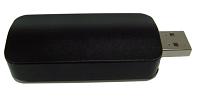
UT100 USB
UT-100 - Features
l USB based modulator/demodulator with support for EN 300-744 DVB-T transmission and reception.
l Powered from the USB bus, so no external power adapter is required.
l Full hardware modulation/demodulation, no host CPU computation required.
Modulator (Transmitter):
l Direct digital conversion to 50..950MHz for excellent signal quality
l Support only non-hierarchy mode
l Programmable digital attenuator
l Free Windows Stream Player
l Free Windows and Linux SDK
Demodulator (Receiver):
l Support Worldwide Free to Air Digital Terrestrial (DVB-T) Receptions (5/ 6 / 7 / 8 MHz)
l Standard Windows DVB-T BDA driver provided
l Windows Media Center compatible DVB-T TV tuner
UT-100 - Applications
l DVB-T signal generator
l Demonstrations
l Research and development
l Video Broadcast/Distribution
l Digital Signage
l Wireless Display
Host Requirements
l CPU: Intel, AMD, ARM, MIPS
l 128MB RAM of system memory or above
l Higher CPU and memory required if DVB-T audio/video decoding is needed.
l One available USB2.0 or 1.1 port
Note: USB 1.1 can only support 3~5 Mbps stream data rate.
|
Parameter |
Value |
|
RF Connector |
Two 75-Ω MCX (female) connecters, one for Tx and one for Rx |
|
Bandwidth |
5/6/7/8 MHz |
|
FFT |
2K, 8K |
|
Code rate |
1/2, 2/3, 3/4, 5/6, 7/8 |
|
Guard interval |
1/4, 1/8, 1/16 or 1/32 |
|
Frequency range |
50 .. 950MHz VHF 6M BW/UHF 6M BW: Channel: CH7~CH83 VHF 7M BW/UHF 7M BW: Channel: CH5~CH69 VHF 8M BW/UHF 8M BW: Channel: CH5~CH69 |
|
RF Output Level |
0 dBm (108 dBuV) |
|
Digital Attenuator |
Range:+6/-25dB* , Step size 1dB |
| MER |
35dB Typically |
|
Spectrum Shoulder (Adjacent channel) |
45dB |
| Phase noise | <-92dBc @ 10kHz |
|
Carrier Suppression |
>42dB |
|
USB port |
USB 2.0 or USB 1.1 |
|
Power |
5V DC (USB Bus Power) 390mA (Tx and Rx) 170mA(Rx only) 340mA(Tx only) |
|
Dimensions (LxWxH) |
75x 30 x 15mm |
Note: There could be MER loss in high gain/attenuation level.
Digital Signage Application Scenario-Wireless
Digital Signage Application Scenario-Wired
